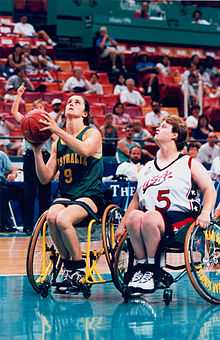4 point player

4 point player is a disability sport classification for wheelchair basketball.
History
The classification was created by the International Paralympic Committee and has roots in a 2003 attempt to address "the overall objective to support and co-ordinate the ongoing development of accurate, reliable, consistent and credible sport focused classification systems and their implementation."[1]
Sport
This classification is for wheelchair basketball.[2] Classification for the sport is done by the International Wheelchair Basketball Federation.[3] Classification is extremely important in wheelchair basketball because when players point totals are added together, they cannot exceed fourteen points per team on the court at any time.[4] Jane Buckley, writing for the Sporting Wheelies, describes the wheelchair basketball players in this classification as players having: "Normal trunk movement but some reduced lower limb function as they unable to lean to both sides with full control."[2] The Australian Paralympic Committee defines this classification as: "Players with normal trunk movement, but usually due to limitations in one lower limb they have difficulty with controlled sideways movement to one side."[5] The International Wheelchair Basketball Federation defines a 4 point player as "Normal trunk movement, but usually due to limitations in one lower limb they have difficulty with controlled sideways movement to one side."[6] The Cardiff Celts, a wheelchair basketball team in Wales, explain this classification as, "able to move the trunk forcefully in the direction of the follow-through after shooting. Class 4 players are able to flex, extend and rotate the trunk maximally while performing both one-handed and two-handed passes and can lean forward and to at least one side to grasp an over-the-head rebound with both hands. Class 4 players are able to push and stop the wheelchair with rapid acceleration and maximal forward movement of the trunk. Typical Class 4 Disabilities include : L5-S1 paraplegia, with control of hip abduction and extension movements on at least one side. Post-polio paralysis with one leg involvement. Hemipelvectomy. Single above- knee amputees with short residual limbs. Most double above-knee amputees. Some double below-knee amputees." [7]
Strategy
4 point players and 4.5 point players receive less playing time than 1 point players because of their higher point value.[8]
On court ability
4 point players can move their wheelchairs at a significantly faster speed than 1 point players.[9]
There is a significant difference in special endurance between 2 point players, and 3 and 4 point players, with 2 point players having less special endurance.[9]
In games, 4 point players steal the ball three times more often than 1 point players.[9] 4 point players generally have the greatest number of rebounds on the court because of competitive advantage when under the basket in terms of height, stability and strength.[9] 4 point players turn over the ball with much greater frequency than 1 point players.[9]
Getting classified
Wheelchair basketball players who are going to compete at the 2012 Summer Paralympics in this classification need to have their classification be in compliance with the system organised by the IWBF and their status being listed as ‘Review’ or ‘Confirmed’.[10]
In Australia, wheelchair basketball players and other disability athletes are generally classified after they have been assessed based on medical, visual or cognitive testing, after a demonstration of their ability to play their sport, and the classifiers watching the player during competitive play.[11]
Once a player is classified, it is very hard to be classified into a different classification. Players have been known to have issues with classification because some players play down their abilities during the classification process. At the same time, as players improve at the game, movements become regular and their skill level improves. This can make it appear like their classification was incorrect.[8]
Variants
Wheelchair Twin Basketball is a major variant of wheelchair basketball.[12] This version is supposed by the International Stoke Mandeville Wheelchair Sports Federation, [12] and played in Japan.[13] Twin basketball has a three-point classification system based on the evaluation of the mobility of people with cervical cord injuries. In this variant, the equivalent to 4 point players would be players without a head band. These players are "Players without a headband (no band players) - the players possess good triceps, a good balance of the hand and some finger functions. They can score by shooting with a smaller and lighter basketball to the normal basket."[12]
Competitors
Australian Brett Stibners is a 4 point player.[14] Cobi Crispin, Bridie Kean, Liesl Tesch and Leanne Del Toso are 4 point players for Australia's women's national team.[15] Adam Lancia is a 4 point player for the Canadian men's national team.[16]
See also
External links
References
- ↑ "Paralympic Classification Today". International Paralympic Committee. 22 April 2010. p. 3.
- ↑ 2.0 2.1 Buckley, Jane (2011). "Understanding Classification: A Guide to the Classification Systems used in Paralympic Sports". Retrieved 12 November 2011.
- ↑ "IPC CLASSIFICATION CODE AND INTERNATIONAL STANDARDS". International Paralympic Committee. November 2007. p. 21. Retrieved 18 November 2011.
- ↑ "Wheelchair Basketball". International Paralympic Committee. Retrieved 18 November 2011.
- ↑ "Classification Information Sheet: Wheelchair Basketball". Sydney, Australia: Australian Paralympic Committee. 27 July 2010. p. 2. Retrieved 18 November 2011.
- ↑ "International Wheelchair Basketball Federation Functional Player Classification System". International Wheelchair Basketball Federation. December 2004. p. 8. Retrieved 18 November 2011.
- ↑ "Simplified Rules of Wheelchair Basketball and a Brief Guide to the Classification system.". Cardiff Celts. Retrieved 22 November 2011.
- ↑ 8.0 8.1 Berger, Ronald J. (March 2009). Hoop dreams on wheels: disability and the competitive wheelchair athlete. Routledge. p. 28. ISBN 978-0-415-96509-5.
- ↑ 9.0 9.1 9.2 9.3 9.4 Doll-Tepper, Gudrun; Kröner, Michael; Sonnenschein, Werner; International Paralympic Committee, Sport Science Committee (2001). "Organisation and Administration of the Classification Process for the Paralympics". New Horizons in sport for athletes with a disability : proceedings of the International VISTA '99 Conference, Cologne, Germany, 28 August-1 September 1999 1. Oxford (UK): Meyer & Meyer Sport. pp. 355–368. ISBN 1841260363. OCLC 48404898.
- ↑ "Wheelchair Basketball: LONDON 2012 PARALYMPIC GAMES". International Paralympic Committee. Retrieved 18 November 2011.
- ↑ "Understanding Classification". Sydney, Australia: Australian Paralympic Committee. Retrieved 18 November 2011.
- ↑ 12.0 12.1 12.2 Strohkendl, Horst (2002). "WHEELCHAIR TWIN BASKETBALL... an explanation". International Stoke Mandeville Wheelchair Sports Federation. p. 9-10. Retrieved 22 November 2011.
- ↑ IWAYA, TSUTOMU. "INSTRUCTION MANUAL FOR TWIN BASKETBALL GAMES - FOR PEOPLE WITH CERVICAL CORD INJURIES". Retrieved 22 November 2011.
- ↑ "Brett Stibners". Basketball Australia. Retrieved 6 November 2011.
- ↑ "2010 WC Team". Basketball Australia. Retrieved 18 November 2011.
- ↑ "Team Canada: Men's Roster". Canada: Wheelchair Basketball Canada. 2011. Retrieved 18 November 2011.
| ||||||||
